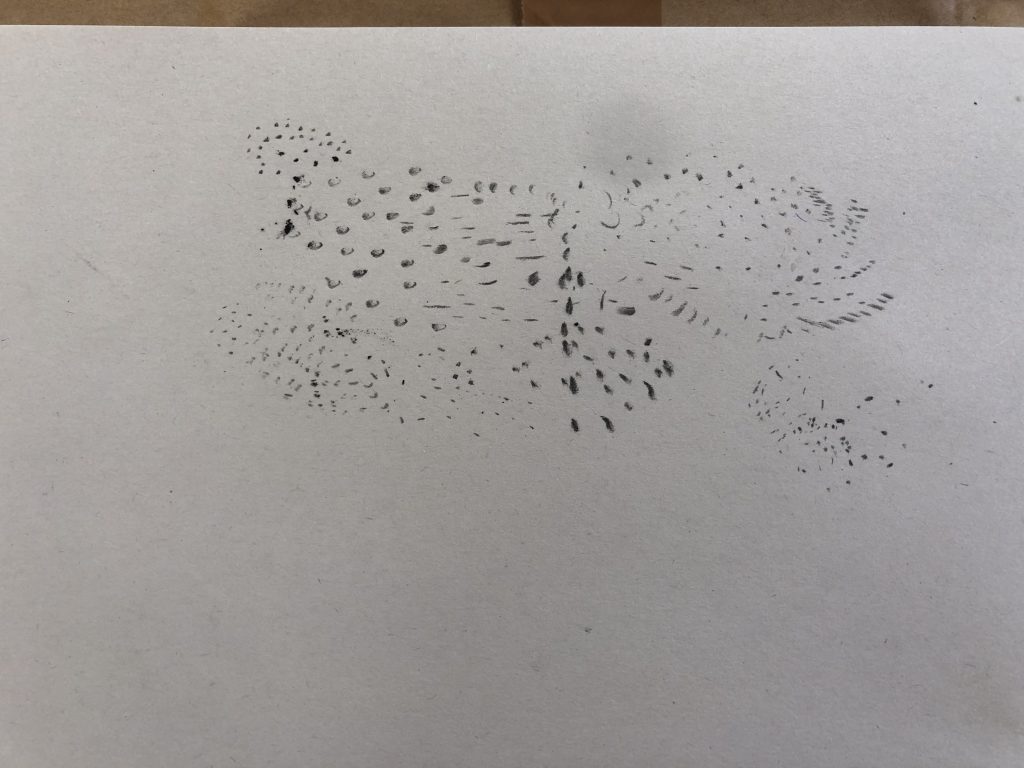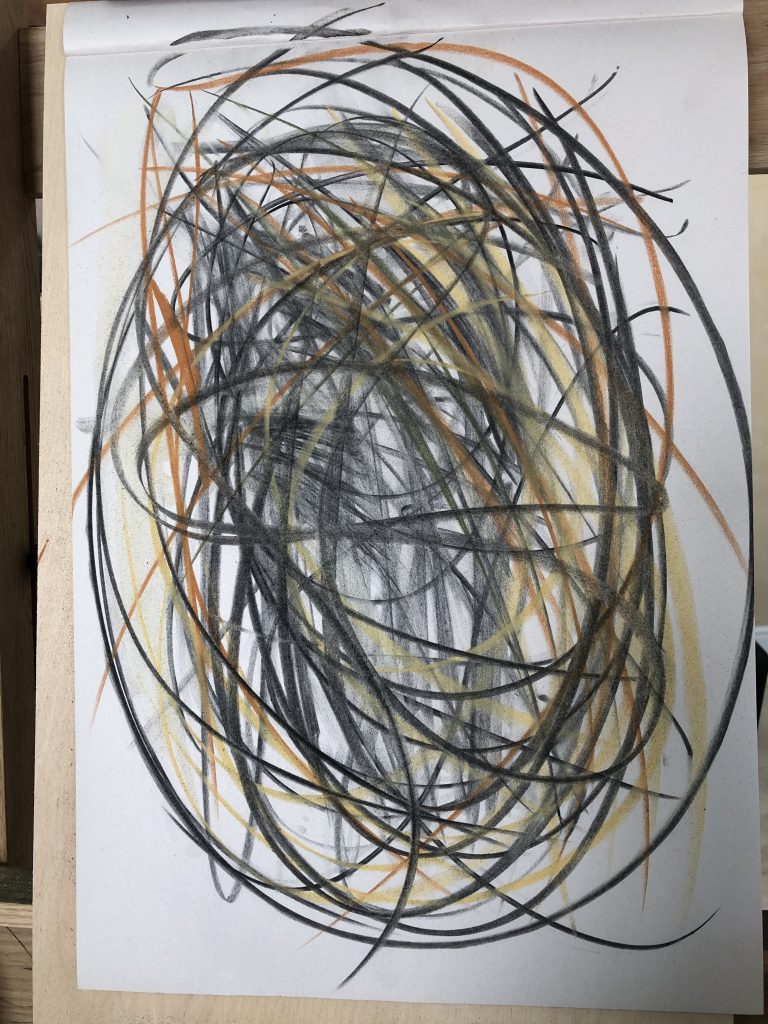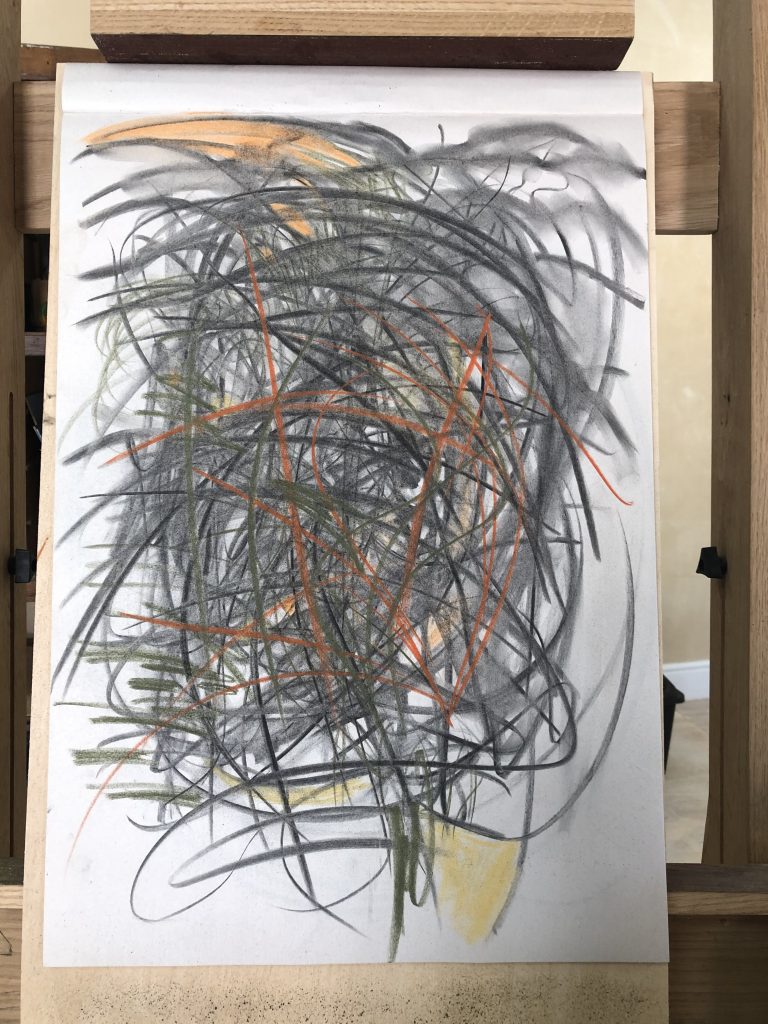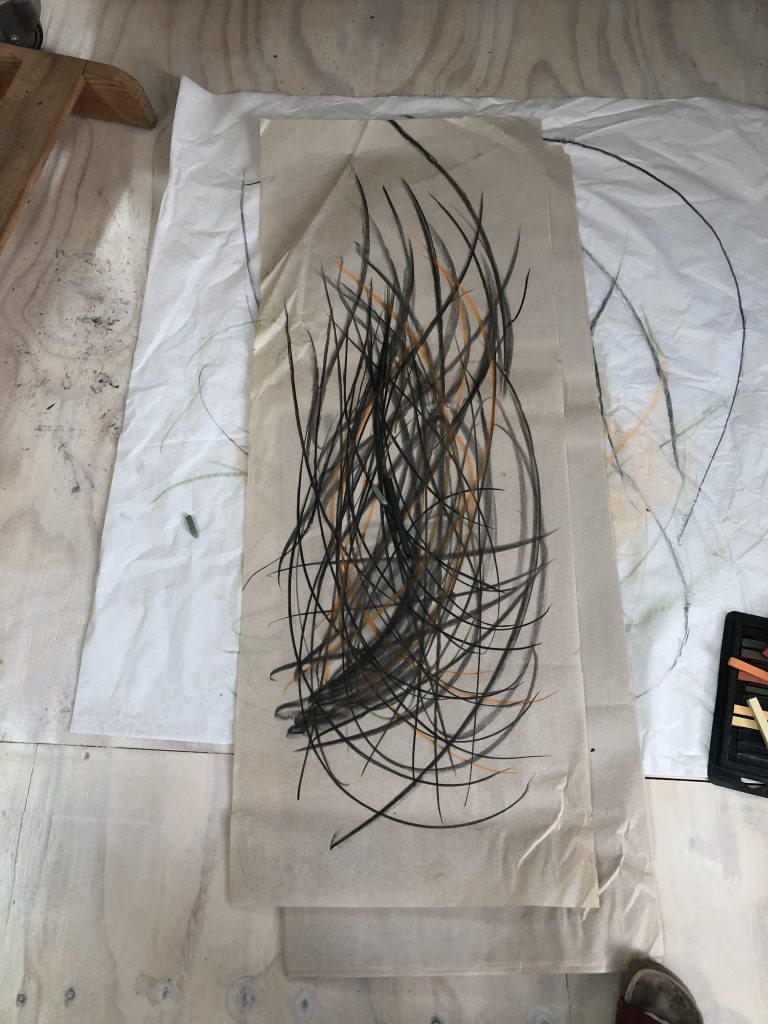PART ONE: PAINTING AND/AS PERFORMANCE
Exercise 1 Smallest to largest reach
This is a drawing exercise with repeated activities which focus on, breathing, sound, rhythm, and the relationship of the whole body to the surface of the drawing, as well as the nature of the experience if you draw with both hands. It also suggests exploring the quality of line I am able to make and placing the focus on what I am doing, rather than on the visual qualities of the marks.
I repeated the actions by making separate drawings of gestural marks with :
- using fingers only, the smallest marks I can make;
- using my hand, articulated from the wrist;
- using my hand, articulating the lower part of my arm from the elbow;
- using my hand, articulating my whole arm from the shoulder and through the elbow and wrist.
Fig. 7 Video of mark making, below
Reflection on essay of B Bryson
“Towards the end of his life, Matisse, like Picasso, consented to be filmed at work in his studio. Part of the film was shot in slow motion, distending the movement of hand and brush in time so that each stroke seemed a gesture of consummate deliberation; as though in slowing the movements down the film were able to demonstrate for the first time a dimension of intention and decision that would never otherwise become known. Let us stay with this scene of suspense: the brush, held a few inches from the canvas, begins an arc that moves in slow motion closer and closer to the surface; the point of the brush contacts the canvas, and as the hairs bend, a smooth, even trace of pigment appears; as the brush is still completing that first arc, a second movement begins in the painter’s arm, commencing at the shoulder, which moves towards the easel; at the same time, the elbow moves out from the easel, so that the wrist can rotate and realign, like a lever, all the angles of the fingers. The brush, unaware of these developments, is still completing its first movement, but at a certain moment its trajectory changes, slowly lifting from the surface at an angle different from that of its arrival; the trace becomes slender, its edges curving inwards as the hairs of the brush come together, exuding a thick, rich trail of pigment until, as the brush lifts from the canvas altogether, the last filament breaks with the surface, to complete the stroke in space.” Bryson,1983:38 (The Invisible Body pdf)
I asked myself about the sense/why of making this as an exercise…….looking at it lying on the floor, and judging it as separate works. I can imagine my grandchildren walking in and wanting to take part in these actions. Is it because there is playfulness experienced in this exercise, but knowing/expecting when judged it would look like a child’s work? I decided to consider the intent of the exercise. Can I see a mapping out of action in both space and time? Did I achieve that? Awareness is important when it comes to gestures that so easily becomes habits, some good and some which one should consider to change. I see these as great opportunities to be more aware of my own movements with and around work, as well as a way to get out of moments when I feel stuck in my making. I enjoy how charcoal or pastel moves over different paper textures and feel connected to this activity. It reminds of
Reading the essay of Bryson (p38,39) the author made me aware of the movements of the body to create marks on the paper in the studio, ie, how the body performs. By focussing on the actions and sensual experiences of these mark-making exercises, I immediately felt an expressive action was needed to suggest the action (for example using fingers only compared to using the whole arm and shoulder, through the elbow and wrist) and this asked me to work fast/slow as well as soft/hard. I am very aware of the textures I can create with charcoal compared to using a pencil to draw. I wanted to bring in color and added the pastel pencil marks as part of the process, but reflecting on it I have to consider if I was losing focus, as the outcome could have been considered in this thinking. (privileging design over material) I do think that by looking at the lines, the smearing marks almost asked for color options as to experiment with this process? There was a focussed awareness of how movements differ through the different actions with hand and rest of body, as well as how it made me react to when the mark-making tools touched the paper, as well as hearing the sounds of this contact. When focussing on breathing the marks became connected to the length of a breath as well as the process of in-breaths and out-breaths. It almost felt necessary to start moving into working with both hands – it reminds me of mixing and blending actions all being intuitive, but also a signal of encouraging openness. I was contemplating the fact that I play the piano, that after 3 years I have access to my piano (was in storage whilst we lived in Dubai). I start with a melody (memory or improvise) – like a line, but then continue to bring in chords or other sounds, use both hands: some work and sound better than others. I do feel the idea is very much about gesture and movement of my body whilst at work and thinking, about using my fingers, hands, arm, and body, and also letting the process unfold.
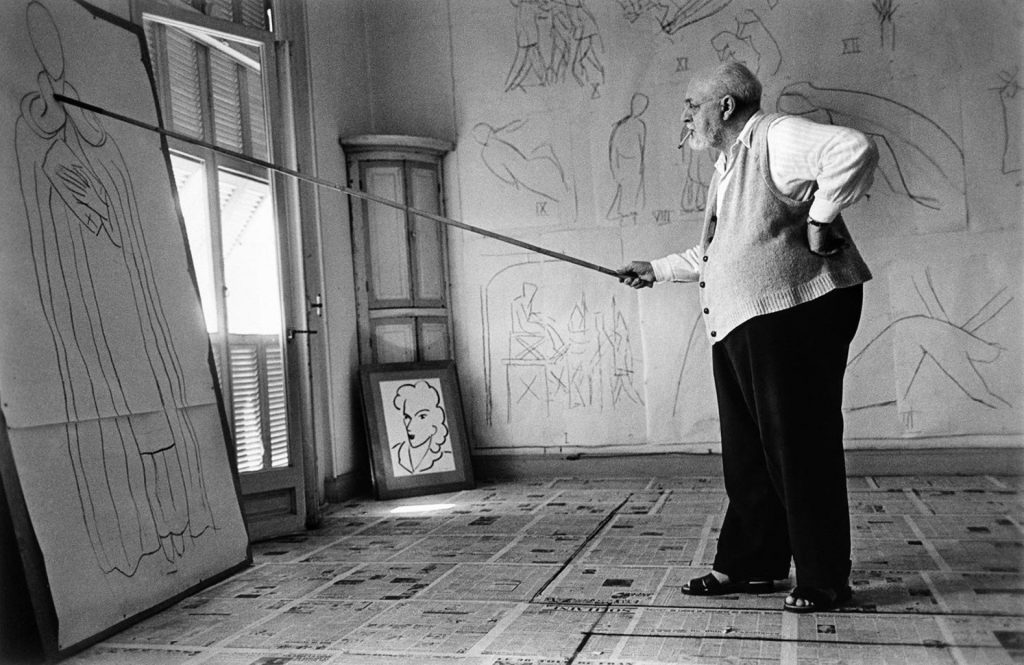
Gestural is a term used to describe the application of paint in free sweeping gestures with a brush(Tate.org.uk)
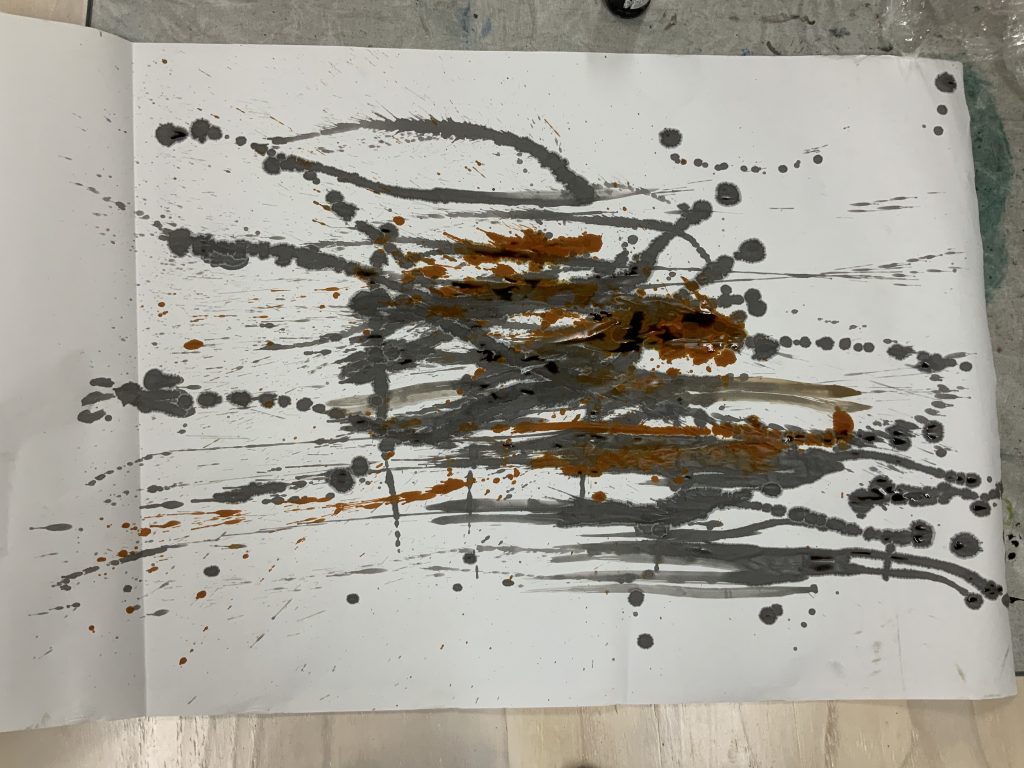
Above is a drawing I made with ink using big sized brushes and throwing techniques whilst standing over the roll of paper lying on the floor. By working on the floor with a fluid material and standing over the work I used bigger gestures to work and could see how chance played out as actions changed and wet materials came into contact with one another. In the work below I used acrylic inks, acrylic medium and gravity to explore gestural marks on velour paper.
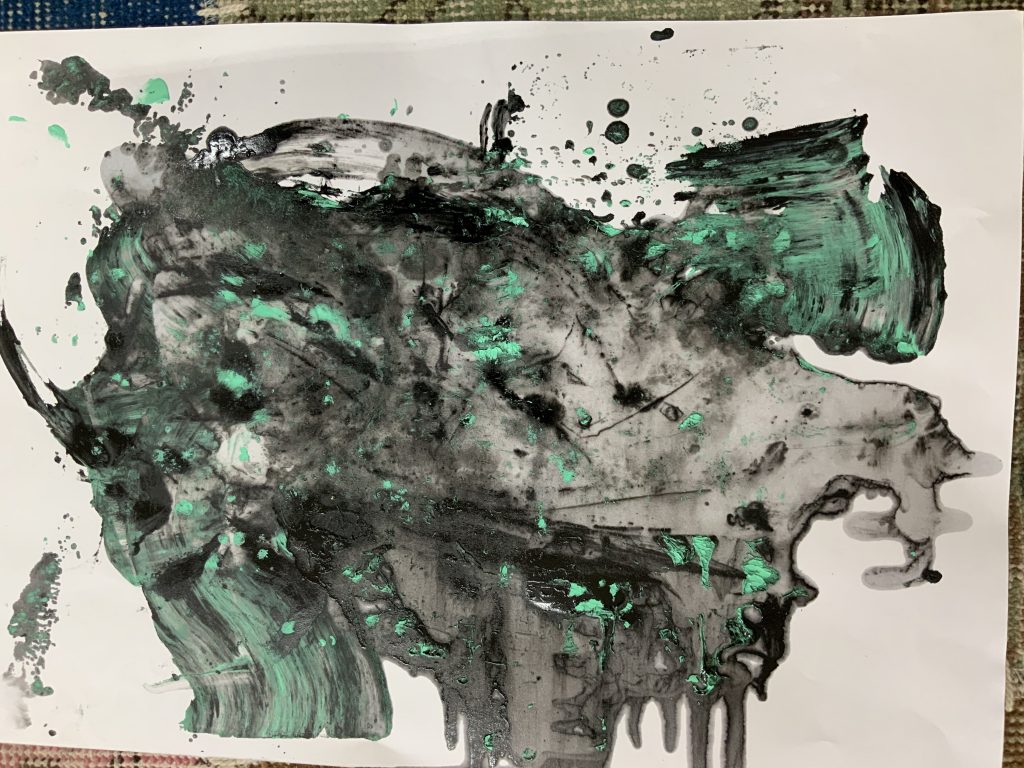
READING POINTS
Work of Julie Mehretu
On the OCA library, I read a paper that examines the series, Grey Area (2007-2009) of the artist. The author, Heidi Bickis, strongly emphasizes the artist’s use of lines as an exploration of space between bodies. In this series, the artist used gestural tracings as well as neatly traced lines. It is my understanding that Mehretu work is composed of two ‘drawn languages’ ( 2016,136), namely being intuitive, expressive, and gestural, and the other being rational. The rationale is borrowed from architectural plans, photographs of different maps, and grids. In this way, she investigates relationships around identity, history, and place. Bickis use a quote of the artist where the artist refers to her mark-making as ‘signifiers of social agency, as individual characters’ (2016, 126-127) I also understand her work as biographical and a thought experiment about her own experience and reaction to social space. In this way, she is interpreting and her work becomes an engagement as much as an analysis of place/space.
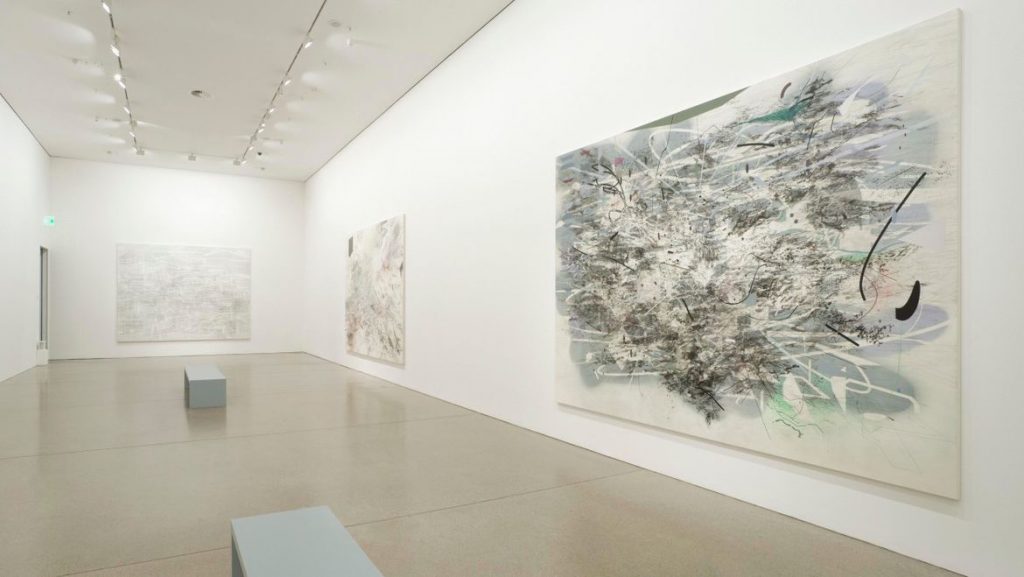
Installation view: Julie Mehretu: Grey Area, Deutsche Guggenheim Berlin, October 28, 2009–January 6, 2010. Photo: Mathias Schormann
The description of being close to view the work, by Bickis (2016, 128-129)was insightful. She describes the work as it is a series that consists of 7 pieces, all the same size, some works use blurred lines which bleed into one another. Her opinion is that the lines are reminiscent of Chinese calligraphy, never just representation, always a nuance of not being fixed form. She also refers to the visual difficulty a viewer experiences, due to this lack of clear form, which refers to incomplete figurations and spaces, markings that overlay. I get the feeling it would be good to almost sitting on the work – and view it from different viewpoints – the body is asked to stretch across the canvas, not only the eyes. Bickis remarks that a gallery guard explained to her that people want to touch and move their bodies into the work, which made the exhibit difficult – as the guard had to constantly ask people to move away from the works of art! It does take me to my own questions about boundaries and space and how we are connected to space. I feel there is an awareness of liminal experience in these works, of how we feel in-between spaces/places as well as how we can give shape and form to our worldly experience. I would like to explore a bigger canvas for my own works. I feel I have never given myself this type of permission, and am aware that it is a personal judgement.
William Kentridge’s works played in my mind and I am aware of his making videos of these actions and how he applies this as a choreographic performance, which to me is his showing of the mechanisms through which he constructs meaning. The below video is part of the lectures the artist was invited to present and from the start he uses drawing of words and mark-making as a part of his lecture/performance.
I would also like to bring in my walking practice as I see walking as an act or performance around place and displacement. I am thinking of the town I currently live nearby (I live on a farm, 8km’s from town) and how to critically engage with that space which has a history of boundaries/barriers (racial segregation due to Apartheid) but also is a place to explore for its wine and olive producing, as well as natural beauty. I want to engage in conversations with people and places. I am more aware of ‘forced pedestrianism’ here, compared to my own luxury of making choices of where, when, and how or with whom I walk. I will look at the work of Doreen Massey to contextualize my learning. Ideas are developing around using a map combined with soundscapes that could take a walker around town to listen to stories of history, memory, loss and daily living. The way I am looking at it is to give authority to the narrative and not a physical map. In my mind it can become an appropriation of digital tools to create a new experience and move through a space, an embodied experience, that I am seeking to share. I hope a user/walker can in this way discover the ‘unexpected’, just like explore gestures with materials in the above exercises.
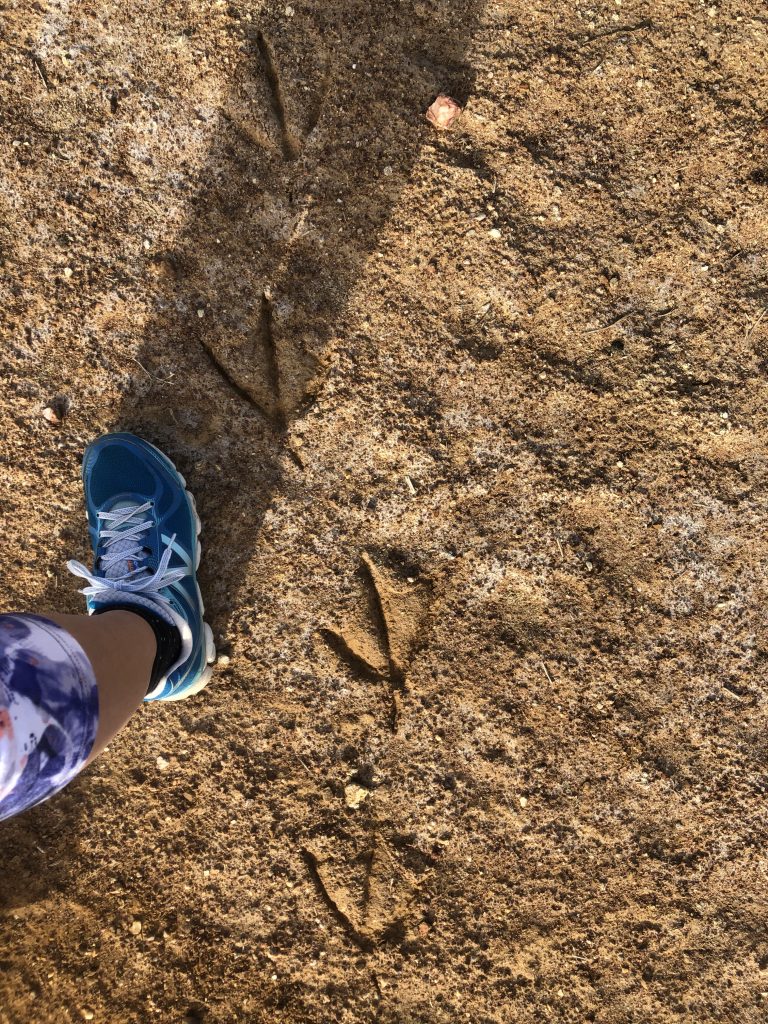
List of Illustrations
Figures 1 – 6 Exercises of gestural marks
Figure 7
Figure 8
Figure 9
Figure 10
Bibliography
Bickis, Heidi, 2016. Inhabiting grey space and unraveling bodily outlines: Engaging with Julie Mehretu’s lined abs-tractions. SagePup Pdf [online] Available at: https:// journals-sagepub-com.ucreative.idm.oclc.org (accessed online on 8/06/21)
Draw, Isabelle,, Lajer-Burcharth, Ewa, Painting beyond itself the medium in the post-medium condition Digital copy from contentstore.cla.co.uk
Kentridge William, Drawing Lesson 1 (. ) At:
Henri Matisse at work (2018) [online] At: https://www.youtube.com/watch?v=rDLg6pCn8Bk (Accessed 05/06 2021).
YouTube. (2018). Henri Matisse at Work in 1946 – Young Woman in White. [online] At: https://www.youtube.com/watch?v=jJX3s1DkeDw [Accessed 05 June 2021].
Henri Matisse speaking about drawing and painting. [2018] At: https://www.youtube.com/watch?v=MiEIeitUNFs&feature=youtu.be [Accessed 05/06/21 ].
Childish Gambino – This is America (2018) [Music Video] At:
https://www.youtube.com/watch?v=VYOjWnS4cMY (Accessed
24/08/20).
